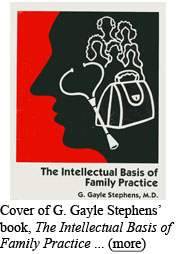A Specialty for Generalists (cont'd.)
Many pioneering family practitioners wrote of their ambitions and ideals for the new specialty, but none wrote more memorably than G.
Gayle Stephens.(23) Stephen's book, The Intellectual Basis of
 Family Practice has been called "the Bible of Family Medicine" both by the
founder of Family Medicine at UMass, Dr. Richard (Dick) Walton, and by the current chair of the department, Dr. Daniel Lasser. Stephens
has been recalled as the "philosopher" among the specialty's founders, but what is chiefly meant by this designation is not merely his
capacity to theorize about the intellectual justification for Family Medicine's holistic approach to patient care, but his effort to
theorize about the intellectual potential of Family Medicine as a base for behavioral and social science research.(24)
Family Practice has been called "the Bible of Family Medicine" both by the
founder of Family Medicine at UMass, Dr. Richard (Dick) Walton, and by the current chair of the department, Dr. Daniel Lasser. Stephens
has been recalled as the "philosopher" among the specialty's founders, but what is chiefly meant by this designation is not merely his
capacity to theorize about the intellectual justification for Family Medicine's holistic approach to patient care, but his effort to
theorize about the intellectual potential of Family Medicine as a base for behavioral and social science research.(24)
For example, in 1975 in answer to the question, "Why Family Practice?" Stephens succinctly suggested how Family Medicine could turn the general art of medicine into the focused and research-generating knowledge of a medical specialty:
Patient management is the quintessential skill of clinical practice and is the area of knowledge unique to family physicians. Family physicians know their patients, know their patients' families, know their practices, and know themselves. Their role in the health care process permits them to know these things in a special way denied to all those who do not fulfill this role. The true foundation of family medicine lies in the formalization and transmission of this knowledge.(25)
Stephens's claim was a simple one: the doctor-patient relationship would be the special area of Family Medicine's expertise, and the "patient" would be taken to include not only a single individual, but a complex figure embedded in a social, familial environment to which the physician must be attuned. At a time when public policy was calling for more comprehensive, continuous medical care, Family Medicine thus based the claim to specialty status on its ability to turn such attunement into a valid field of systematic research.(26) Underlying these claims is the assumption that there are many forms of valid knowledge, many valid methodologies for acquiring such knowledge, and many important reasons for the health care practitioner to utilize them.
Nevertheless, as Stephens and others realized, Family Medicine must adapt to the basic ground rules for "academic" medicine in order to be accepted as an equal: it must be grounded in scientific knowledge and, like other specialties, must claim expertise in a distinctive area of knowledge to which its practitioners regularly contribute new research. These new doctors must have the benefit of specialized residency training. By 1966, both the Millis and the Willard reports also specifically called for primary care physicians who were residency-trained.(27)
So when I was seeing textbooks, the Gayle Stephens text, or just regular textbooks on family medicine, that was new to me. I actually thought [Family Medicine] was just a little OB, a little surgery, a little orthopedics, a little medicine, all mushed together in the ambulatory setting with people seeing patients in the inpatient setting. I didn't appreciate that it was actually a discipline unto itself. That was a real eye-opener and a real - almost an inspiration, I would say, because after that, I continued in family medicine education, so it must have done something, because if it was just the practice piece I wouldn't be here today doing what is really much more of an academic role. I didn't actually appreciate, not only family medicine as a discipline, but academic Family Medicine as a potential career, so there were a lot of surprises for me.--Michele Pugnaire
During the years preceding the acceptance in 1969 of the American Board of Family Medicine as the official certification body for a new specialty, several experimental family medicine departments were established in other regions of the country, cohering mainly around the education of residents. One of these, organized by William Willard around 1955 or 1956, was located at the University of Kentucky Medical School and was considered a bellwether for programs founded in the ensuing decade; another early program was created by G. Gayle Stephens in Wichita, Kansas. The demographic characteristics of such programs were something of a harbinger: general practice may have been declining, but physicians serving relatively rural parts of the country were determined to provide a substitute for their already under-served populations.(28)
